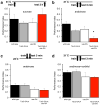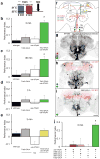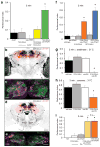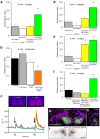Layered reward signalling through octopamine and dopamine in Drosophila
- PMID: 23103875
- PMCID: PMC3528794
- DOI: 10.1038/nature11614
Layered reward signalling through octopamine and dopamine in Drosophila
Abstract
Dopamine is synonymous with reward and motivation in mammals. However, only recently has dopamine been linked to motivated behaviour and rewarding reinforcement in fruitflies. Instead, octopamine has historically been considered to be the signal for reward in insects. Here we show, using temporal control of neural function in Drosophila, that only short-term appetitive memory is reinforced by octopamine. Moreover, octopamine-dependent memory formation requires signalling through dopamine neurons. Part of the octopamine signal requires the α-adrenergic-like OAMB receptor in an identified subset of mushroom-body-targeted dopamine neurons. Octopamine triggers an increase in intracellular calcium in these dopamine neurons, and their direct activation can substitute for sugar to form appetitive memory, even in flies lacking octopamine. Analysis of the β-adrenergic-like OCTβ2R receptor reveals that octopamine-dependent reinforcement also requires an interaction with dopamine neurons that control appetitive motivation. These data indicate that sweet taste engages a distributed octopamine signal that reinforces memory through discrete subsets of mushroom-body-targeted dopamine neurons. In addition, they reconcile previous findings with octopamine and dopamine and suggest that reinforcement systems in flies are more similar to mammals than previously thought.
Conflict of interest statement
The authors declare no competing financial interests.
Figures




Comment in
-
Reward: Finding the paths to food reward.Nat Rev Neurosci. 2012 Dec;13(12):816. doi: 10.1038/nrn3397. Nat Rev Neurosci. 2012. PMID: 23165253 No abstract available.
Similar articles
-
Sweet taste and nutrient value subdivide rewarding dopaminergic neurons in Drosophila.Curr Biol. 2015 Mar 16;25(6):751-758. doi: 10.1016/j.cub.2015.01.036. Epub 2015 Feb 26. Curr Biol. 2015. PMID: 25728694 Free PMC article.
-
Concerted Actions of Octopamine and Dopamine Receptors Drive Olfactory Learning.J Neurosci. 2020 May 20;40(21):4240-4250. doi: 10.1523/JNEUROSCI.1756-19.2020. Epub 2020 Apr 10. J Neurosci. 2020. PMID: 32277043 Free PMC article.
-
Appetitive learning requires the alpha1-like octopamine receptor OAMB in the Drosophila mushroom body neurons.J Neurosci. 2013 Jan 23;33(4):1672-7. doi: 10.1523/JNEUROSCI.3042-12.2013. J Neurosci. 2013. PMID: 23345239 Free PMC article.
-
Reinforcement signalling in Drosophila; dopamine does it all after all.Curr Opin Neurobiol. 2013 Jun;23(3):324-9. doi: 10.1016/j.conb.2013.01.005. Epub 2013 Feb 5. Curr Opin Neurobiol. 2013. PMID: 23391527 Free PMC article. Review.
-
Octopamine in the mushroom body circuitry for learning and memory.Learn Mem. 2024 Jun 11;31(5):a053839. doi: 10.1101/lm.053839.123. Print 2024 May. Learn Mem. 2024. PMID: 38862169 Free PMC article. Review.
Cited by
-
The neuronal architecture of the mushroom body provides a logic for associative learning.Elife. 2014 Dec 23;3:e04577. doi: 10.7554/eLife.04577. Elife. 2014. PMID: 25535793 Free PMC article.
-
Octopamine mediates starvation-induced hyperactivity in adult Drosophila.Proc Natl Acad Sci U S A. 2015 Apr 21;112(16):5219-24. doi: 10.1073/pnas.1417838112. Epub 2015 Apr 6. Proc Natl Acad Sci U S A. 2015. PMID: 25848004 Free PMC article.
-
Gustatory learning and processing in the Drosophila mushroom bodies.J Neurosci. 2015 Apr 15;35(15):5950-8. doi: 10.1523/JNEUROSCI.3930-14.2015. J Neurosci. 2015. PMID: 25878268 Free PMC article.
-
Multiple neurons encode CrebB dependent appetitive long-term memory in the mushroom body circuit.Elife. 2018 Oct 22;7:e39196. doi: 10.7554/eLife.39196. Elife. 2018. PMID: 30346271 Free PMC article.
-
Identification and characterization of mushroom body neurons that regulate fat storage in Drosophila.Neural Dev. 2018 Aug 13;13(1):18. doi: 10.1186/s13064-018-0116-7. Neural Dev. 2018. PMID: 30103787 Free PMC article.
References
-
- Dayan P, Balleine BW. Reward, motivation, and reinforcement learning. Neuron. 2002;36:285–298. - PubMed
-
- Wise RA. Dopamine, learning and motivation. Nat Rev Neurosci. 2004;5:483–494. - PubMed
-
- Liu C, et al. A subset of dopamine neurons signals reward for odour memory in Drosophila. Nature. 2012 - PubMed
-
- Hammer M. An identified neuron mediates the unconditioned stimulus in associative olfactory learning in honeybees. Nature. 1993;366:59–63. - PubMed
Publication types
MeSH terms
Substances
Grants and funding
LinkOut - more resources
Full Text Sources
Molecular Biology Databases

